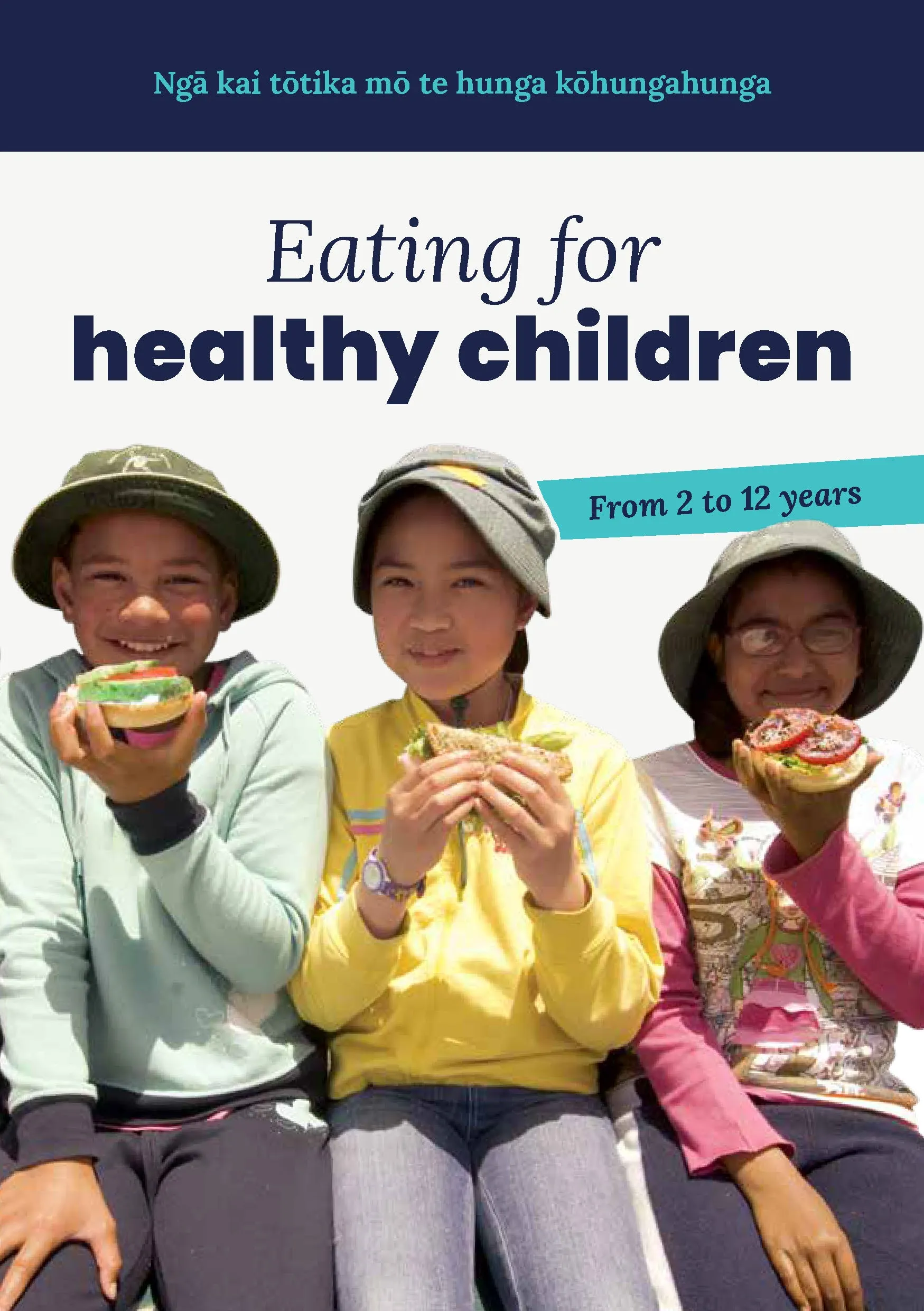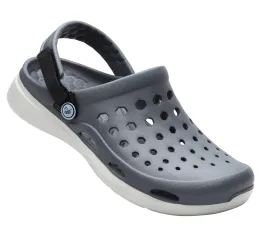Everyone needs to be active and eat well to be healthy. Being healthy increases your quality of life and your sense of wellbeing.
This booklet gives advice for parents, whānau and caregivers on the types of food children need to eat to be healthy. It also describes how children can be active in everyday life.
Teach children to make healthy food choices
Do more of these
- Make mealtimes fun – where family/whānau can catch up and share their day.
- Have meals together as a family (when possible) and turn off the TV and cellphones.
- Have meals at times that suit children – this may mean having meals earlier than you are used to.
- Provide three healthy meals every day, including breakfast.
- Provide a wide variety of healthy foods for children to choose from.
- Take your children food shopping and encourage them to choose healthy foods, such as fruit and vegetables, for the trolley.
- Encourage children to try new foods.
- Make preparing food fun – involve children from an early age and let them do more as they get older.
- Make children’s serving sizes smaller than an adult’s – most children don’t need to eat as much as adults.
- Encourage family members to stop eating when they feel full.
- Offer healthy snacks (low in fat, salt and sugar) between meals.
Do less of these
- Keep takeaways for occasional meals only (less than once a week), not as everyday foods.
- Limit fruit juice and dried fruit – they contain a lot of sugar.
Don’t do these
- Don’t use rewards or force or push a child to eat.
- Don’t encourage continuous eating or grazing – stick to set meal and snack times.
Be a positive role model – if you make healthy food choices, then your children are more likely to do the same.
Offer many different foods
Children need to eat many different foods to be healthy and to grow. The four main food groups contain a mixture of carbohydrate, fat, protein, vitamins and minerals – all of which children need as they grow.
Choose a variety of foods from the four food groups every day:
- .
* Legumes include cooked dried beans, peas and lentils.
Note that the serving sizes in this booklet may be too big for younger children to eat in a single meal. You can divide one serving into several smaller amounts for your child to eat throughout the day.
Vegetables and fruit
Vegetables and fruit provide carbohydrate, fibre, vitamins and minerals and are low in fat. They should be eaten with most meals and are good snack foods.
- Choose fresh, frozen or canned vegetables and fruit. Buying “in season” vegetables and fruit keeps their costs down.
- Offer a mixture of raw and cooked vegetables and fruit with the meal or snack.
- Provide many different coloured vegetables and fruit; for example, tomato or strawberry, broccoli or kiwifruit, carrot or mandarin, eggplant or plum, potato or pear.
What is one serving?
- 1⁄2 cup of cooked vegetables or 1 cup of salad
- 1⁄2 medium potato, or similar size piece of kūmara, yam, or taro
- 1 medium apple, pear, banana or orange
- 1 cup of fresh or stewed fruit salad
*Some raw vegetables and fruit may be too hard for young children to chew and grind up well. See the section.
How many serves of fruit and vegetables do they need?
| Age Group | 2-3 | 4-8 | 9-11 | 12-13 |
Vegetables | Girls | 2.5 | 4.5 | 5 | 5 |
Boys | 5.5 | ||||
Fruit | Girls | 1 | 1.5 | 2 | 2 |
Boys |
Breads and cereals
Children need to eat breads and cereals every day, as these are the best source of energy for the body.
- These foods include breads, breakfast cereals, rice, noodles and pasta. They provide carbohydrate (which can be an important source of energy and fibre) and some vitamins and minerals.
- Breads and cereals are healthy snack foods for schoolchildren.
- Include wholegrain varieties (eg, rolled oats, brown rice or bread with whole grains), as they are higher in fibre, vitamins and minerals.
What is one serving?
- 2 breakfast wheat biscuits
- 1⁄2 wholegrain bread roll or 1 sandwich slice of whole grain bread
- 1⁄2 cup of cooked porridge/rolled oats or ¼ cup of muesli
- 1⁄2 cup of cooked pasta or brown rice
How many servies of bread and cereals do they need?
Age Group | 2-3 | 4-8 | 9-11 | 12-13 |
Girls | 4 | 4 | 4 | 5 |
Boys | 5 | 6 |
Milk and milk products
Milk provides energy, protein, and many vitamins and minerals, including calcium. Children and preschoolers need milk and milk products to help build strong bones and teeth.
- When children are 2 years of age, you can choose to gradually introduce reduced-fat (light blue lid) and low-fat (yellow or green lid) milk and milk products.
- Encourage children who don’t drink milk to eat other milk products such as yoghurt, low-fat home made fruit smoothies, custard, milky soups, and cheese.
What is one serving?
- 1 cup (250 ml) low or reduced fat fresh, UHT long life, reconstituted powdered milk or buttermilk
- 2 slices (40 g) or a 4 x 3 x 2 cm piece of cheese such as Edam
- ¾ cup (200 g) low- or reduced-fat yoghurt
- 1 cup (250 ml) calcium-added plant-based milk alternatives (eg, soy, rice, almond, oat milk) (with at lest 100 mg of added calcium per 100 ml).
How any serves of milk and milk products do they need?
Age Group | 2-3 | 4-8 | 9-11 | 12-13 |
Girls | 1.5 | 1.5 | 3 | 3.5 |
Boys | 2 | 2.5 |
Lean meats, chicken, seafood, eggs, legumes, nuts and seeds
These foods all contain protein, which is important for children’s growth. They also contain fat and many different vitamins and minerals – especially iron, which is important for the blood and brain.
- The body absorbs iron from lean meats, chicken and seafood (ie, from animals) more easily than iron from plants such as legumes.*
- To help absorb iron, include foods rich in vitamin C with meals. Fresh fruits and vegetables, especially oranges, kiwifruit, tomatoes and broccoli, are rich sources of vitamin C.
- To reduce the amount of fat, buy lean meat (when possible), cut off any fat you can see from meat and chicken. Children need to eat some fat, but too much can lead to health problems later in life.
- Limit processed meats, such as luncheon, salami, bacon and ham, as they are usually high in fat and/or salt.
* Legumes include cooked dried beans, peas and lentils.
What is one serving?
- 1 cup of cooked dried beans, peas or lentils
- Small handful (30 g) of nuts or seeds†
- 1 large piece of cooked fish (100g)
- 2 eggs
- 1⁄2 chicken breast or 2 chidken drumsticks (80 g)
- 2 slices (65 g) of cooked meat (eg, roast lamb, beef or pork)
- 1⁄2 cup of mince or casserole (65 g)
How many serves of lean meats, chicken, seafood, eggs, legumes, nuts and seeds do they need?
Age Group | 2-3 | 4-8 | 9-11 | 12-13 |
Girls | 1 | 1.5 | 2.5 | 2.5 |
Boys |
Vegetarians
Well balanced vegetarian diets need to include a range of vegetables and fruit, breads, cereals, legumes (dried peas, beans and lentils), milk products, eggs, nuts and seeds†. If your child does not drink cow’s milk, offer soy milk with added calcium and vitamin B12. If you are concerned that your child isn’t getting a balanced diet, ask a dietitian or registered nutritionist for advice. For more information, see the Ministry of Health booklet ).
† To reduce the risk of choking, do not give small hard foods – such as whole nuts and large seeds – until children are at least 5 years old. See the section.
Small meals and snacks
Children need to eat regularly during the day. To meet their growth and energy needs, provide three meals and two or three snacks during the day. Snacks should not take the place of a meal, but think of them as a mini-meal that supplies energy, protein, vitamins and minerals.
Choose healthy snacks that are low in fat, salt and sugar.
Healthy snack suggestions
- Vegetable sticks* – keep these in the fridge. Serve with cottage cheese or hummus.
- Cold cooked vegetables – cook a few extra potatoes, or pieces of kūmara and taro at mealtimes.
- Fresh fruit* – serve whole or cut up with yoghurt.
- Frozen fruit – bananas, oranges, canned unsweetened pineapple or peaches.
- Sandwiches – banana, yeast- based spread, cheese, cottage cheese, baked beans or peanut butter. Spread margarine or butter thinly. You can also use bread, bread rolls, rēwena bread, crackers, rice cakes, crumpets, pita bread, toasted muffins and baked bread fingers.
- Toasted English muffins, crackers, fruit buns, scones, fruit bread, pancakes.
- Cereals – choose cereals that are low in sugar.
- Popcorn – pop using a little oil, margarine or butter or use a microwave. Don’t give popcorn to children under 3 years of age.*
- Yoghurt, milk or slices of cheese.
* The size or texture of some foods may need changing. See the section.
Picky or fussy eating
Picky or fussy eating is common in young children – but most will eat when they are hungry. Try the ideas listed at the . You may need to offer new foods many times before your child will eat them. Young children can have around one and a half cups (350 ml) of milk a day – if they have too much milk they may not eat enough food to keep them healthy.
Let your child control how much food they eat – make mealtimes fun rather than a battleground. Talk to your doctor if you are worried about your child’s picky eating.
Young children and choking
It’s quite easy for young children to choke on food. This is because they are still learning how to chew and grind food well.
To reduce the risk of choking:
- always make sure young children sit down to eat and that an adult is with them while they are eating or drinking
- offer food that matches their ability to chew and grind
- if you need to make chewing and grinding easier, change the texture of the food – grate, cook, finely chop or mash it
- remove the high-risk parts of the food – peel off the skin or remove any strong fibres
- avoid giving small hard foods, such as whole nuts and large seeds, until children are at least 5 years old.
Having plenty to drink
Children need plenty of water to keep their bodies working. They need to drink more when they are active and when it’s hot.
Children need lots of small drinks through the day. Keep offering drinks, as they may forget to drink when they are active and become dehydrated (lose too much water), which can be serious for young children.
Give more of these
- Water is best – it’s cheap and easy to get. Keep a jug of cold water in the fridge.
- Milk is also a good drink for children because it contains energy, protein and many vitamins and minerals. Serve milk after meals or as part of a healthy snack between meals.
Give less of these
- Fruit juice is not recommended as it is high in sugar, which can cause tooth decay. If using, dilute juice with water (at least 1⁄2 a cup of water to every 1⁄2 a cup of juice) and have it with a meal rather than on its own. This may help to protect teeth from the sugar.
- Soft drinks are high in sugar and and sometimes contain caffeine. They should be ʻoccasionalʼ drinks (less than once a week).
Don’t give these
- Don’t give tea or coffee to children. The caffeine in tea and coffee can affect children’s sleep and cause dehydration. Other substances in tea and coffee can reduce the amount of iron children can absorb from food.
- Don’t give energy drinks, energy shots or drinks containing guarana. They contain caffeine and many are high in sugar.
Foods that are high in fat, sugar or salt
Children need healthy food most of the time. It’s all right to eat foods that are high in fat, sugar or salt occasionally (less than once a week), but not every day. Too much of these foods can cause health problems such as obesity (being very overweight), diabetes and high blood pressure.
Foods that are high in fat, sugar or salt include muesli bars, sweets/lollies, fruit leathers and roll-ups, potato chips, chocolates, sweet biscuits, meat pies, takeaways and soft drinks.
Choose healthier takeaways
Most takeaways are high in fat and salt. Have them on special occasions and not as an everyday food. Some lower fat takeaways include:
- kebabs and wraps
- pizza with more vegetables than cheese
- sushi
- pasta with tomato-based sauces
- thick chunky chips or wedges instead of thin chips
- rice- and noodle-based takeaways (not fried) with lots of vegetables
- baked potatoes with meat, beans and salad.
Reading food labels
Food labels have a lot of information on them, some of which may help you to make healthy food choices. To find out more about reading food labels, see Ministry for Primary Industries' resource
Food allergies and intolerances
Food allergies and intolerances may affect 4–8 percent of children, although many children outgrow them over time. For more information, see the Ministry for Primary Industries’ resource and website. If you suspect your child may have a food allergy or intolerance, it’s important you talk to your doctor about it.
Children should be active every day
Sit less
Reducing sitting time by encouraging regular movement is important for all children. This includes providing regular active breaks for children travelling on long car journeys. Daily screen time should be limited to less than 1 hour for 2- to 4-year olds. Children aged 5 and over should limit recreational screen time to less than 2 hours a day.
Legally, children have to be restrained when travelling for their safety. For more information see
Move more
Regular physical activity and play is important for healthy growth and development. Encourage children to be active in as many ways, and as often as possible.
- Children aged 2- to 4-years need at least 3 hours of fun active play spread throughout the day. At least 1 hour of this should be energetic play, such as running (try games such as ‘tag’), riding a bike, or bouncing on a trampoline.
- Children aged over 5 years should do at least 1 hour of moderate to vigorous activity every day. Try to do vigorous activities that strengthen muscles and bones at least 3 days a week, such as running, jumping and skipping.
Try different activities to find ones your children enjoy. Give them a go as a family and involve everyone in deciding what to try. Support children in these activities and give feedback and praise.
| Moderate activities | Vigorous activities |
Children are breathing faster and their hearts are beating a bit more. They can still talk! | Children are puffing and their hearts are beating faster. They can only say a few words without taking a breath. |
Walking the dog Biking on the flat Playing at the park or pool Ballet, modern dance Kapa haka Skateboarding | Running, skipping and jumping games Mountain biking Uphill tramping Fast lap swimming Summer and winter sports Waka ama |
Sleep well
Getting enough good quality sleep is really important for children’s wellbeing. In order to achieve a good quality sleep:
- Maintain a calm, consistent bedtime routine. This may include a warm bath, dressing in bedclothes, brushing teeth and reading a story.
- Avoid any TV or other electronic devices or bright lights for at least 1 hour before bed.
- Promote independent sleep by putting toddlers to bed when they are tired, but not asleep.
- Encourage your child to go to bed and wake up at the same time each day.
- Toddlers aged 1–2 years need 11–14 hours of good quality sleep every day, including at least 1 daytime sleep.
- Pre-schoolers aged 3–4 years need 10–13 hours of good quality sleep every day.
- Children aged 5–13 years need 9–11 hours of sleep a night.
For more information
Talk to your:
- doctor, practice nurse or public health nurse
- local Public Health Service dietitian or registered nutritionist
- marae-based health services and/or Māori health workers
- Pacific health workers.
For healthy meal ideas and recipes, look for these websites:
On the Internet, look for these websites:
Ask your doctor, practice nurse or public health nurse for:
- – code HE1230
- – code HE1519
- – code HE2312.
These brochures can also be downloaded or viewed online at
ISBN 978-0-478-19373-2 (print)
ISBN 978-0-478-19374-9 (online)















